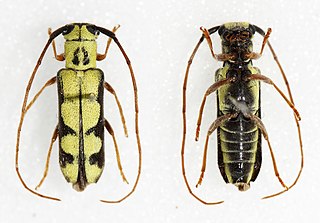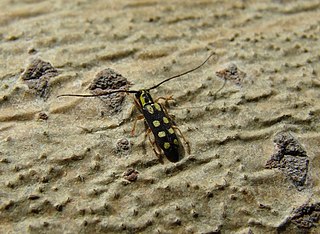
The bushwren, also known as the mātuhituhi in the Māori language, was a very small and almost flightless bird that was endemic to New Zealand. It had three subspecies on each of the major islands of New Zealand, the North Island, South Island, and Stewart Island / Rakiura and nearby smaller islands. The species disappeared gradually after the introduction of invasive mammalian predators, last being seen on the North Island in 1955 and the South Island in 1968. Attempts were made to save the remaining population on small islands off Stewart Island, but they ultimately failed with the death of the last remaining known birds in 1972.
The long-footed potoroo is a small marsupial found in southeastern Australia, restricted to an area around the coastal border between New South Wales and Victoria. It was first recorded in 1967 when an adult male was caught in a dog trap in the forest southwest of Bonang, Victoria. It is classified as vulnerable.

The Kashmir cave bat is a species of vesper bat. It is endemic to the Western Himalayas of South Asia. It is found in the Western Himalayan broadleaf forests ecoregion, within Bhutan, India, Nepal, Pakistan, and Afghanistan.

The Savanna swamp shrew is a species of mammal in the family Soricidae. It is endemic to Nigeria. Its natural habitat is swamp.

The North Island robin is a species of Australasian robin endemic to the North Island of New Zealand. It and the South Island robin of the South Island and Stewart Island were once considered conspecific, but mitochondrial DNA sequences have shown that the two lineages split prior to the Pleistocene, and support the classification as two different species.

Anthracodromeus is an extinct genus of Late Carboniferous "protorothyridid" tetrapods known from Ohio. It is known from the holotype AMNH 6940, a nearly complete skeleton. It was collected in the Linton site in Jefferson County, from the Allegheny Group. A. longipes was first assigned by Edward Drinker Cope in 1875 to a species of Sauropleura. The genus was first named by Robert L. Carroll and Donald Baird in 1972 and the type species is Anthracodromeus longipes. It is amongst the oldest known tetrapods to display adaptations for climbing.

Saperdini is a tribe of longhorn beetles of the subfamily Lamiinae.

Menesia is a genus of longhorn beetles of the subfamily Lamiinae, containing the following species:

Panulirus longipes, the longlegged spiny lobster, is a species of spiny lobster that lives on shallow rocky and coral reefs in the tropical Indo-Pacific region. The International Union for Conservation of Nature has assessed its conservation status as being of "least concern".
Menesia bimaculata is a species of beetle in the family Cerambycidae. It was described by Stephan von Breuning in 1954. It is known from Borneo.
Menesia burmanensis is a species of beetle in the family Cerambycidae. It was described by Stephan von Breuning in 1954.
Menesia javanica is a species of beetle in the family Cerambycidae. It was described by Stephan von Breuning in 1954. It is known from Java.
Menesia nigriceps is a species of beetle in the family Cerambycidae. It was described by Per Olof Christopher Aurivillius in 1903. It contains the varietas Menesia nigriceps var. inhumeralis.
Menesia nigricornis is a species of beetle in the family Cerambycidae. It was described by Per Olof Christopher Aurivillius in 1913. It is known from Borneo.
Menesia sexvittata is a species of beetle in the family Cerambycidae. It was described by Stephan von Breuning in 1962. It is known from Java.
Menesia walshae is a species of beetle in the family Cerambycidae. It was described by Stephan von Breuning in 1960. It is known from Java.

Menesia bipunctata is a species of beetle in the family Cerambycidae. It was described by Zoubkov in 1829, originally under the genus Saperda. It has a wide distribution in Europe and Asia. It measures between 6 and 9 mm. It feeds on Juglans regia and Frangula alnus.

Menesia flavotecta is a species of beetle in the family Cerambycidae. It was described by Heyden in 1886. It is known from Japan, Russia, China, and possibly Mongolia.

Menesia sulphurata is a species of beetle in the family Cerambycidae. It was described by Gebler in 1825, originally under the genus Saperda. It is known from Mongolia, Kazakhstan, Japan, China, and Russia.
Menesia transversenotata is a species of beetle in the family Cerambycidae. It was described by Heller in 1924. It is known from the Philippines.









